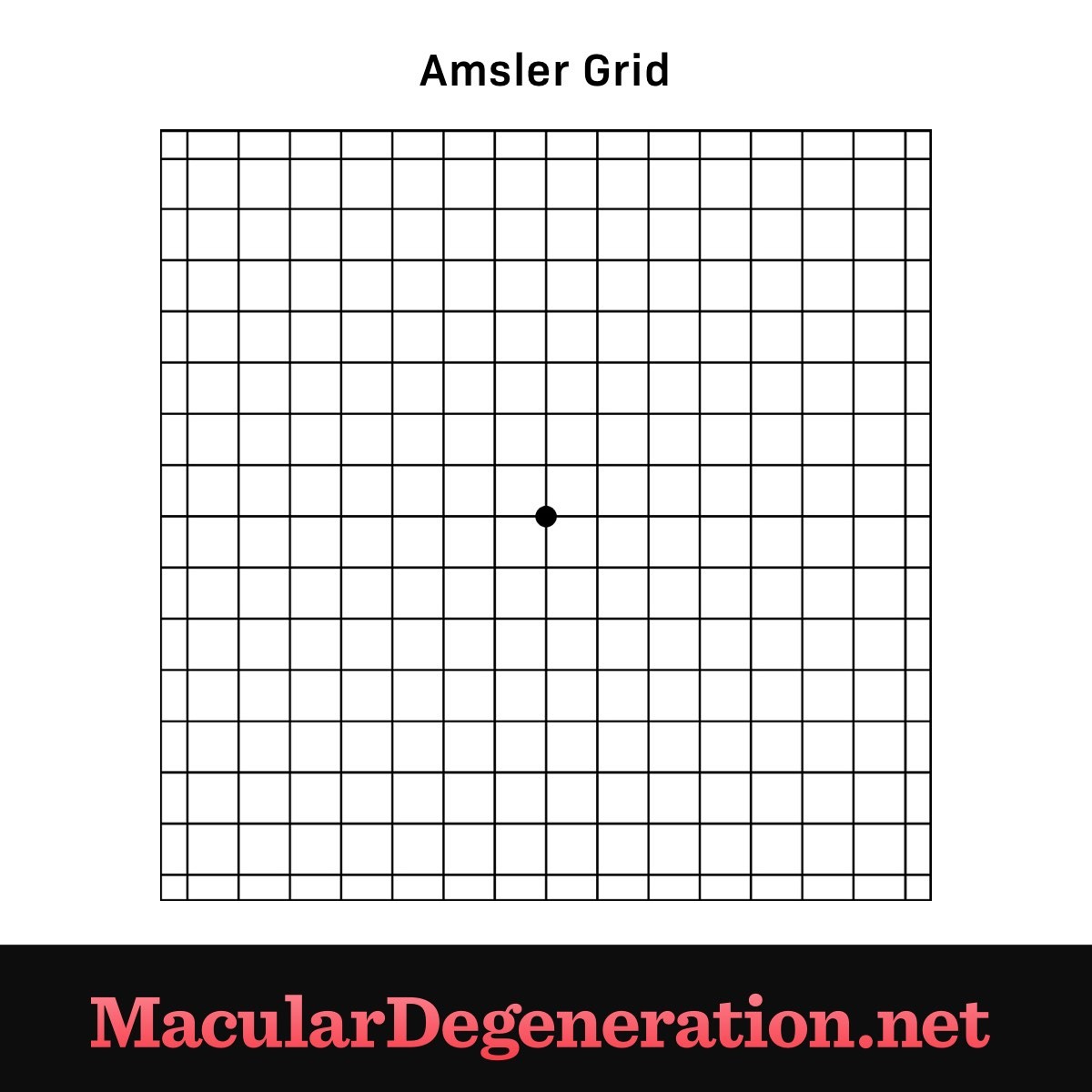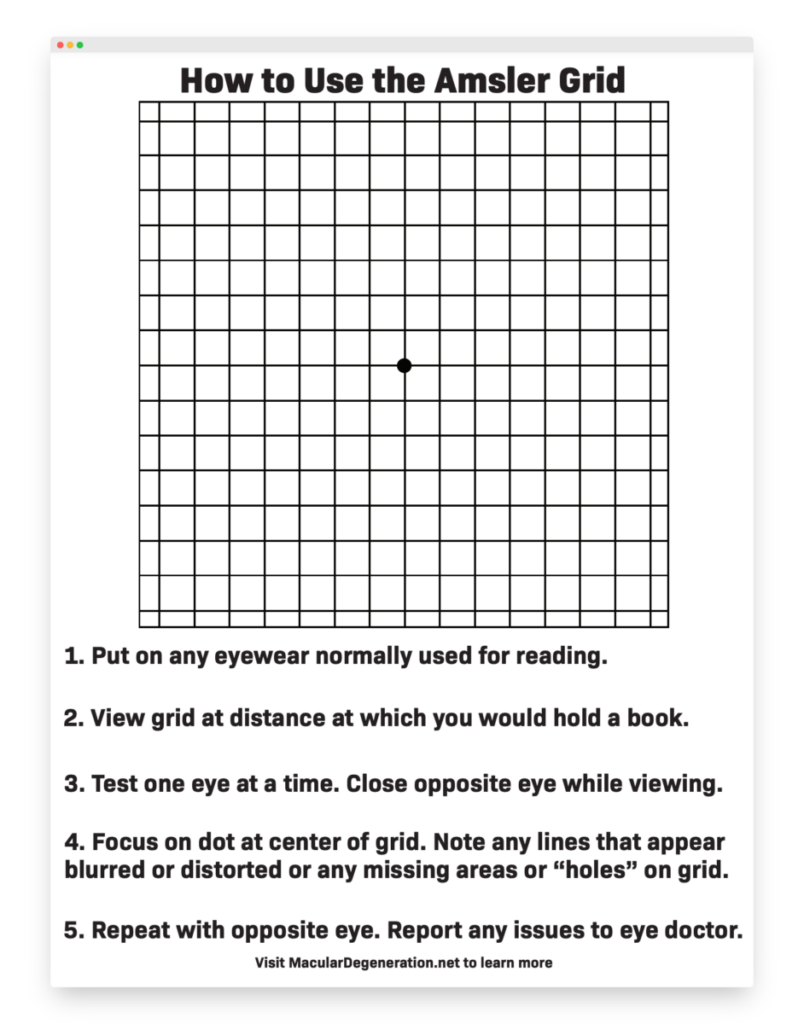Vision Tests: Visual Acuity Test and Amsler Grid

A diagnosis of macular degeneration is made as a result of a comprehensive dilated eye exam, which includes a variety of tests, including a visual acuity test and Amsler grid. Taken together, along with photographs and scans of the back of the eye, the information provided by these tests gives your eye doctor an idea of your eye health and vision and allows them to make a confident diagnosis of macular degeneration.
What does the visual acuity test measure?
The visual acuity test measures how well you see at various distances. When you hear the expression “20/20 vision,” it describes normal visual acuity, or the sharpness of your vision, at a distance of 20 feet.1 The term 20/20 refers to the fact that you can see clearly at 20 feet what is normally seen at that distance. If your vision is 20/150, you see at 20 feet what others with normal vision see at 150 feet.
What is visual function?
Even if you have 20/20 vision, this doesn’t mean your vision is without problems. This does not take into consideration peripheral vision, ability to focus, depth perception, color vision, or anything else, except for how clearly you can see something at a distance. It is merely one part of the eye exam and does not determine the visual function (your ability to perform visual tasks and activities).
What is the visual acuity test?
The test itself is done right in the doctor’s office, and is the “eye chart test” you probably think of when you think of vision testing. It’s done with either a standardized chart (called a Snellen chart) or on a video monitor, and you may be asked to remove your glasses or contact lenses.
If it’s been done less than 20 feet away from you, a special chart will be used to account for this.2 You will either cover one eye with your hand or use a paddle to cover one eye while you read the smallest line you can clearly see with the uncovered eye. The process is then repeated with the other eye. <Click here to download your eye visual acuity test guide.>
Amsler grid
The Amsler grid is a tool that is not only used during an eye exam for diagnosis, but can also be used to monitor the progression of the disease, track visual changes associated with the transition from dry to wet AMD, and can also be used at home to monitor for changes in vision such as new blind spots or metamorphopsia (wavy lines). It is a grid with black lines on a white background, although sometimes it’s white lines on a black background.
It looks like graph paper, but there’s a small dot in the center of the grid. When you go to the doctor, you can ask her for one to take home with you.
Amsler grid instructions
- Put on reading glasses, contacts, or any necessary eyewear.
- Hold the grid at a distance at which you can get most of the lines in focus; for most people, it’s the same distance at which you would hold a book.3
- Close or cover one eye and look at the grid.
- When you’re done with one eye, cover the other eye, so that you test one eye at a time.
If you try testing with both eyes open at the same time, your brain may ignore your worse eye and focus only on your better eye, which could cause you to miss any changes that might be occurring with your vision.
Interpreting the Amsler grid
If you see a little waviness of the lines, that could be from drusen that have built up under the retina causing small distortions in the retina. But if the waviness gets worse, that could signal the progression of the disease, and you should call your doctor. An eye that has wet AMD or “wet” myopic macular degeneration will typically see some curved lines or an area that has a gray or black spot. This may be from fluid or blood that has built up under the retina.3
How to use an Amsler grid
In order to get your baseline for the Amsler grid, when you go to the doctor, look at the grid. What you see at that visit is your baseline. Any change from that is a signal that something may be awry. It’s recommended to check your eyes with the Amsler grid once a week; put it somewhere easily accessible or visible such as on the refrigerator to serve as a reminder.3
Keeping track of visual changes
The visual acuity test and Amsler grid are just two of the tools that your eye doctor will use to help him/her make the diagnosis of macular degeneration. They are often part of the larger comprehensive dilated eye exam, and the Amsler grid is something you can do at home to monitor your progression.
If you notice any changes in your visual field or how you see things, call your doctor – even if you just had an eye exam. Early diagnosis and treatment is important with MD, and even a month or two can make a difference.
This article was published on February 21, 2019 by MacularDegeneration.net c|net and authored by the Editorial Team. To read the original article, you can visit this link – https://maculardegeneration.net/vision-tests/?via=recommend-reading
Click here to learn about the 5 Worst Eye Problems that can affect the elderly.
If you or a loved one has been diagnosed with Macular Degeneration, we have created this free resource to help <click here> to download your copy.
About New England Low Vision and Blindness
New England Low Vision and Blindness uniquely brings hope through technology, training, and care. We are a full-service assistive technology rehabilitation training provider. We offer nearly 100% of all major electronic low vision, blindness, and software products. and have two (2) assistive technology showroom centers – one in Worcester, MA, and a second in Shelton, CT.
At each of our technology showrooms, we provide ‘patient choice’ showcasing numerous technology options from the world’s most respected suppliers, all in line with one’s individualized budgetary limits and personal, educational or professional goals. We also provide custom training solutions and troubleshooting support.
Widely known, tested, and trusted throughout New England, our team brings 75+ years of low vision experience. Our talent, technology, and training offerings are unmatched and highly respected. We are an extremely unique and extraordinary resource for anyone suffering from vision loss in New England. We are here to help.
Through our free demonstrations – either at one of our conveniently located assistive technology showrooms or in their home, office or school – clients experience a relaxed 2-hour free personal demonstration of almost 100% of all low vision and blindness technologies available on the market.
To learn more about how we Bring Hope to people who are blind or with low vision, contact a Technology Specialist at New England Low Vision and Blindness please call our toll-free number 888-211-6933 or email us at info@nelowvision.com.




